9am – 1pm Tehachapi RCD, 321 West C St., Tehachapi, Ca. 93561
Pre-Orders must be received by April 12, 2018 Our Online Store is coming soon.
Tehachapi is in Sunset Home and Garden zones 1, 7….see below
Zone 1A: Coldest mountain and intermountain areas of the contiguous states
Marked by a short growing season and relatively mild summer temperatures, Zone 1A includes the coldest regions west of the Rockies, excluding Alaska, and a few patches of cold country east of the Great Divide. The mild days and chilly nights during the growing season extend the bloom of summer perennials like columbines and Shasta daisies. If your garden gets reliable snow cover (which insulates plants), you’ll be able to grow perennials listed for some of the milder zones. In years when snow comes late or leaves early, protect plants with a 5- or 6-inch layer of organic mulch. Along with hardy evergreen conifers, tough deciduous trees and shrubs form the garden’s backbone. Gardeners can plant warm-season vegetables as long as they are short-season varieties. To further assure success, grow vegetables from seedlings you start yourself or buy from a nursery or garden center. Winter lows average in the 0 to 11°F (–18 to –12°C) range; extremes range from –25 to –50°F (– 32 to –46°C). The growing season is 50 to 100 days.
ZONE 7: California’s Gray Pine Belt, Oregon’s Rogue River Valley, and Southern California mountains
Zone 7 encompasses several thousand square miles west of the Sierra Nevada and Cascade ranges, and in the mountains that separate the Southern California coast from interior deserts. Because of the influence of latitude, this climate lies mostly at low elevations in Oregon’s Rogue Valley, middle elevations around California’s Central Valley, and at middle to higher elevations farther south. Gray pines define the heart of Zone 7 around the Central Valley, but more adaptable incense cedars replace them farther north and south.
Hot summers and mild but pronounced winters give Zone 7 sharply defined seasons without severe winter cold or enervating humidity. The climate pleases plants that require a marked seasonal pattern to do well—flower bulbs, peonies, lilacs, and flowering cherries, for example. Deciduous fruit trees do well also; the region is noted for its pears, apples, peaches, and cherries.
Gardeners in a few spots around the San Francisco Bay will be surprised to find their gardens mapped in Zone 7. These areas are too high and cold in winter to be included in milder Zones 15 and 16. In the mildest parts of Zone 7—in the extreme southern Salinas Valley, for example—you can get away with growing borderline plants such as citrus, oleanders, and almonds if you choose a spot with good air drainage to take the edge off winter chill. At weather-recording stations in Zone 7, typical winter lows range from 35 to 26°F (2 to –3°C), with record lows averaging from 18 to -0° F (–8 to –18°C).
GROUNDCOVERS:

Emerald Carpet Manzanita
Arctostaphylos ‘Emerald Carpet’
(Manzanita)

Emerald Carpet Manzanita
Emerald Carpet manzanita is an evergreen groundcover. Emerald carpet is drought tolerant from Ft. Bragg thru Oregon along the coast, anywhere else, treat as a drought tolerant lawn. This manzanita needs a rich, well- draining soil to look green, in infertile soils it will look yellow. Does ok in inland with 1-3 times/week water. It can be effective as a 1 or 2 plant buffer between a lawn and other manzanitas.

Arctosptaphylos uva ursi ‘Woods Compact’ hybrid, Bearberry Manzanita
Arctostaphylos uva-ursi ‘Woods compact’ hybrid
(Bearberry Manzanita)
This manzanita is a low growing, spreading manzanita with shiny green, rounded foliage, with small bell-shaped flowers and pretty red berries, quite large for the species. This hybrid from coastal Oregon spreads at a moderate pace up to 6-8 feet wide and only growing approx. 8 – 12 inches tall. Full sun to light shade in hot areas with moderate summer water. This ground cover may tolerate infrequent irrigation with afternoon shade during wet winters. This plant is somewhat drought tolerant, requiring water every 10-14 days.

Coyote Brush
Baccharis pilularis ‘Pigeon Point’
(Prostate Coyote Brush)
Coyote brush can be found all over California. Coyote brush is a wiry and woody perennial evergreen. It’s numerous small and stiff grey-green leaves are jagged on the edges, egg- shaped and .5-1.0-inch long. The leaves have a waxy coating that reduces the amount of moisture lost to evaporation. Best of all, the leaves have a chemical makeup that reduces their ability to catch on fire. The leaves become fragrant and sticky with resinous oils on hot summer days. Coyote brush produces male and female flowers on different plants.Blooming in the fall, the white fluffy female and yellowish male flowers grow on separate shrubs. Seeds are small black nuts and hang off a fluffy tuft of hair called a pappus that catch the wind. Hardy to 0°F.
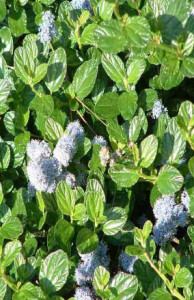
Yankee Point Ceanothus
Ceanothus griseus ‘Yankee Point’
(Mountain Lilac)
Ceanothus Yankee Point’ is an evergreen shrub that commonly grows two or three feet tall and ten feet wide. A mounding mass of glossy green with blue flowers in Mar-May. Does ok inland if given a little afternoon shade and weekly sprinkles. This species the deer love. VERY useful for large bank stabilization. Plant on 10 ft. centers, it will usually be that big in 3 years. If you want fast fill in plant Salvias and Monkey flowers in between. Yankee Point Ceanothus will roll over them leaving color sticking out here and there in the sea of green.
PERENNIALS:

Aquilegia formosa, Western Scarlet Columbine, by Carol Rush
Aquilegia formosa
(Scarlet Columbine)
A member of the Buttercup Family this bright flower is a winter dormant perennial. Columbine will grow up to two to three feet high when ready to flower. It grows wild in the Sierra Nevada, the Tehachapi’s extending over to the coastal ranges on north-facing slopes and along stream beds. It has compound bluish-green leafs, with hanging red and yellow flowers. Blooms from mid-spring into summer and attracts humming birds. Will do well in clay as well as well-drained soil, light to moderate shade and occasional water.

California Buckwheat
Eriogonum fasciculatum
(California Buckwheat)
California Buckwheat is the common one that grows in most areas of California and is hardy and very drought tolerant. Many insects, butterflies, quail, other birds and small animals depend on it for food and shelter. It grows one to two feet tall. Flowers change from pinkish white to rust.

Scarlet Coyote Mint
Monardella macrantha ‘Marian Sampson’
(Scarlet Coyote Mint)
This vigorous, disease-resistant selection originated as a chance seedling at Mourning Cloak Ranch and Botanic Garden in Tehachapi and is named Marian Sampson in honor of one of the garden’s co-founders, Marian and Ed Sampson. The Sampson’s operated a nursery there for many years which offered native plants. This lovely mint is an aromatic mint-family perennial that blooms from late spring through fall with two to four-inch-wide starburst clusters of tubular red-orange flowers, resembling an old-fashioned shaving brush. The blooms attract hummingbirds. This rhizomatous plant grows in loose trailing mats of foliage up to four inches high. The dark green shiny leaves are variable in size and shape and often have purplish highlights on their undersides. It grows in sun to partial shade in well- drained soil and is cold hardy from zero to 10o F, but needs regular watering to establish. In gardens with hot, dry climates it requires moderate supplemental water for best results. It can be grown in a hanging basket or container, in a raised bed or in a wild garden or rock garden. Once established Coyote Mint needs little maintenance except to lightly pinch young stems in early spring and selectively remove long sprawling stems in early winter.

Penstemon eatonii
Penstemon eatonii
(Firecracker)
Penstemon eatonii has leaves arranged in a low rosette next to the ground, and the flowers are borne on vertical flowering stalks 1 ft. to 4 ft. high. The leaves are somewhat rounded. Native to California mountains. Penstemon eatonii needs good drainage and some water in spring and fall and an occasional indirect summer watering. Firecracker Penstemon, with red tubular flowers, is one of the showier Penstemons.

Foothill Penstemon
Penstemon heterophyllus
(Foothill Penstemon)
Foothill Penstemon is long lived (30 years?) perennial with hundreds of one inch violet flowers on three foot spikes in April- Aug. It likes full sun, is drought tolerant, needs good drainage. Penstemon heterophyllus has been alkali tolerant. An excellent dry land garden plant. It looks to be hardy to -10 or less. If you trim the flower heads after the first flowering, you can induce a second flowering. This plant is very, very showy. It is very stable in coastal, desert or mountain plantings, if not overwatered, fertilized or otherwise abused.

Showy Penstemon
Penstemon spectabilis
(Showy Penstemon)
Penstemon spectabilis is a 3′ perennial with lavender flowers in April-June. Native in dry creek beds, hill sides and coastal bluffs of California. A very showy border plant. Showy Penstemon is hardy to 0° F. and full sun at 120+ ° F. Showy Penstemon is easy on all sites. Do not overwater. Needs good drainage and sun.

Blue Eyed Grass
Sisychrinium bellum
(Blue Eyed Grass)
Small, tufted, rhizomatous plants with miniature fans of iris-like foliage. Clusters of purple-blue, saucer shaped flowers with yellow centers. Blooms in spring. Grows six inches to two feet tall.

California Fuchsia
Zauschneria californica
(California Fuchsia)
The California fuchsia is a showy perennial shrub that grows 1-2 ft. high with upright stems. It has gray-green foliage and bright orange-red tubular flowers and attracts hummingbirds. This shrub is a native to California and is drought tolerant.
ORNAMENTAL GRASSES:

Deer Grass
Muhlenbergia rigens
(Deer Grass)
Deer grass is a 3 foot perennial with 2 foot plumes rising above the plant. It looks like a small pampas grass but without the bad leaf cuts and the aggressive seeding. Native to many areas of the California mountains. It grows on banks of seasonal creeks. Use it in dry stream beds or along driveways. Much more useful than Pampas grass because of its size. These plants grow quickly. They normally will grow to mature size in a season or two. Give them sun and enough water to bring the rainfall to 15 inches/year after the first month or so of regular water. Commonly used for making baskets by the California Indians.

Alkali Dropseed
Sporobolus airoides
(Alkali Dropseed)
Sporobolus airoides is described as a perennial grass. It is native to the U.S. Its
most active growth period is in the spring and summer. The greatest bloom is
usually observed in the mid-summer, with fruit and seed production starting in
the summer and continuing until fall. Leaves are not retained year to year. This
variety has a moderate growth rate. At maturity, the typical specimen will reach up to 3 feet high.
SHRUBS:

Louis Edmunds Manzanita
Arctostaphylos bakeri
(Louis Edmunds, Manzanita)
Louis Edmunds manzanita is an eight to ten foot evergreen shrub. The manzanita to plant for the gray foliage and purple, not red, bark. This manzanita is not as drought tolerant as the densifloras nor as tolerant of summer water. It will survive in the interior heat ok, but make sure you keep the water and fertilizer down. This manzanita does fine in heavy clay soils, but also does fine in loam or even granite. When the pink flowers cover the plant in April and May the hummingbirds park in it. Louis Edmunds is a show stopper.

Howard McMinn Manzanita
Arctostaphylos densiflora
(Howard McMinn Manzanita)
A medium-sized, evergreen mounding shrub to 7 to 10 feet tall by as wide with a densely-branched structure – can be kept smaller by pruning. It has beautiful smooth dark red bark and narrow 3/4 to 1 and 1/2-inch-long shiny green leaves. From late winter into spring, intensely showy clusters of many small white flowers appear, tinged with light pink. Hummingbirds and Butterflies like this shrub. Plant in full sun to light shade. This Manzanita tolerates clay soils and sand. Though it requires little irrigation, this plant can tolerate occasional watering, even overhead, which makes it both drought and garden tolerant. It is hardy to 0 to -10°

Four-Wing Saltbush
Atriplex canescens
(Four-Wing Saltbush)
An evergreen perennial rounded shrub with gray-green leaves that is densely branched and grows to five feet high and eight feet wide. It is a long lived plant and grows in a wide variety of soils including saline soils and it tolerates alkalinity. It is very drought tolerant and cold tolerant. In March to September it produces inconspicuous yellow-green clusters of male and female flowers (usually borne on separate plants). The pollen carries significant allergens that affect many people. On female plants masses of yellowish tan conspicuous fruits follow flowering. Each one-half inch size fruit has four papery wings or bracts. The papery seeds attract birds and desert mammals. The extensive root system of this plant is valuable for erosion control and the plant is often used for restoration projects. This shrub can be used for informal or clipped hedges or as a background planting in home gardens. After the fruits have fallen from the plant, the fruit bearing stalks can be pruned to improve the shrub’s appearance. All Atriplex species collect and ultimately remove excess salts in the soil through bladders in their leaves. The leaves retain the salt until the salt is removed from the plant when the leaves age and are shed or eaten.

Atriplex lentiformis, Quailbush, by Bert Wilson, ©Las Pilitas Nursery, used with permission of www.laspilitas.com

Quail Bush, branch & leaves, © 2014 Steve Matson
Atriplex lentiformis
(Quail Bush)
Quail Bush is a spreading shrub can grow up to eight feet. It has scaly gray-green leaves. Grows wild along alkali flats and dry lakes in the Mojave and Sonoran deserts. Good for wind breaks, borders, wild-life habitat and forage. Very tolerant of drought, alkali and poor soils. Requires very little watering after establishment. Also freeze tolerant. Most of this plant is edible, Native peoples used it to add a salty flavor to food. Rabbits and possibly deer may browse this plant, so plant in a wire basket the first year or so.

Bush Anemone
Carpenteria californica
Bush Anemone
Evergreen shrub with ivory and tan bark, leathery dark green lanceolate leaves that are 2 to 5 inches long. Prefers well drained soils, low water and grows best in light shade, but will tolerate either sun or shade. Blooms late spring to early summer. Clusters of fragrant, 1-1/2 to 3 inch yellow-centered white flowers resembling anemones. Can grow 4 to12 feet tall.
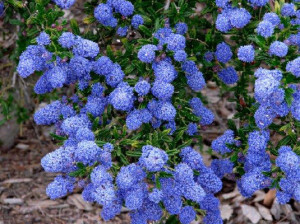
Wild Lilac
Ceanothus concha
(Wild Lilac)
Ceanothus ‘Concha’ grow to about 4′ high by 4′ wide in the interior and deserts. This cultivar has deep blue flowers, is drought tolerant, and garden tolerant. This is one of the few varieties that is alkali tolerant. This is one Ceanothus we have grown in the San Joaquin Valley with no reservations, is cold- hardy to 10 degrees F with no burn, and has recovered from 0 degrees F. The myth of Ceanothus being short lived is primarily spread by incompetent gardeners that insist on applying drip irrigation, summer water and soil amendments. Upland California native plants hate all three. Expect a 20-25 year life in most gardens if you treat Ceanothus as the drought tolerant plants they are.
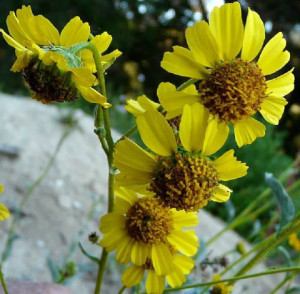
Brittlebush
Encelia farinose
(Brittlebush)
Low, multi-branched shrub to three feet tall. Brittle twigs and dense clusters of broad silvery white leaves. Summer deciduous. Flat topped clusters of bright yellow daisies appear in spring.

Toyon
Heteromeles arbutifolia
(Toyon)
Large evergreen shrub or small tree with leathery green leaves and small white flowers followed by showy clusters of red berries. Deep water once a month in summer when established. Can grow 8-15 feet tall and 8 feet wide. Attracts birds and wildlife.

Toyon Berries

Golden Currant
Ribes aureum
(Golden Currant)
A 3-6′ short deciduous shrub. The flowers are scented yellow. It flowers from April to May. Native to moist areas, central Sierra Nevada east to Rocky Mtns. It likes sun to part shade. It can tolerate standing in water to drought. A very tolerant plant. The fruit is about the size of blueberries and the flavor is excellent. The berries can be either yellow, red, or purple when ripe. The flowers are well liked by the hummingbirds. Very easy to grow. Just water. Hardy to 0° F.

Evergreen Currant
Ribes viburnifolium
Evergreen Currant
This shrub is originally from Santa Catalina Island and Baja California, where it’s becoming rare or threatened in its native habitat. This shrub grows 2 to 3 ft. in height, but can spread up to 8 feet wide. It has small 1/2 to 1 inch lobed leaves. It has dark red “wine” colored flowers with a sweet fragrance. It does best in shade or partial shade. This shrub will do best in at lower elevations, in well drained soils with sand or sandy loam, but can tolerate clay soils. Adding mulch to the soil around this shrub may help it survive extreme temperatures. This lovely currant is somewhat freeze tolerant to 15oF, and drought tolerant in clay soils. This shrub will need some summer water.

California White Sage
Salvia apiana
(California White Sage)
Woody evergreen sub-shrub. Aromatic broad wooly white leaves. Springtime lavender-tinged white blooms on tall willow-like stalks. Blooms attract bees and butterflies. Attractive at night, reflects moonlight or garden lighting. To keep neat, shear lightly after flowering. Drought tolerant. Can grow 3-5 feet tall and 5 feet wide.

Cleveland Sage

Cleveland Sage
Salvia clevelandii
(Cleveland Sage)
Evergreen shrub has highly aromatic gray-green foliage. Unusual flower spikes consist of clusters of blue-violet flowers stacked in whorls. Butterflies and hummingbirds are attracted to the blossoms in the spring. Can grow to 6 feet tall and 6 feet wide.

Purple Flowering Sage
Salvia leucophylla
(Purple Flowering Sage)
Mutli branching shrub to 6 feet tall. Narrow, elliptical, gray-green, quilted leaves. Pale lavender to purple flowers in whorls in early summer. Great for pollinators and birds.

Honey or Black Sage
Salvia mellifera
(Honey or Black Sage)
This evergreen shrub is California’s most common sage and is an important bee plant in the wild. It grows three to six feet tall and three to five feet wide with an upright to spreading form. This sage has oblong to lance-shaped leaves with deep veins. The leaves are aromatic with dark green color above and woolly gray beneath. The plant bears tightly packed whorls of whitish or lavender tinged flowers on long stems. It is drought tolerant and cold hardy. Bees and butterflies love it.
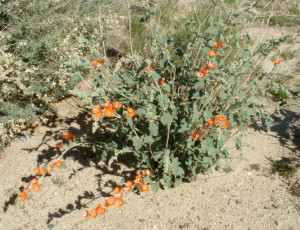
Apricot Mallow
Sphaeralcea ambigua
(Apricot Mallow)
Grayish green plant which grows in clumps. Drought tolerant and does best in full or reflected sun. Orange flowers bloom from March to June
Cut back to six inches in early fall. Can grow 3 feet tall and 3 feet wide.
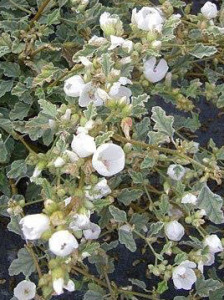
White Globe Mallow
Sphaeralcea fulva ‘La Luna’
(White Globe Mallow)
Hybrid: Native to Baja California, this lovely perennial plant, similar to the Apricot Mallow, is also in the hibiscus family. However, this Globe Mallow has small white cup-shaped flowers instead of orange, with small pink and black floral parts. It has small, grey-green fuzzy lobed leaves, gold colored stems, and will grow very open in shape, to about 3X3 ft. in size. The ‘La Luna’ variety was developed at the Santa Barbara Botanical Gardens. Being a desert plant, it does best in full sun and well drained, sandy soil. It is very drought tolerant, and somewhat freeze tolerant to 20oF. It may not be browse tolerant, so plant in a wire basket. As in the Apricot Mallow, some people maybe be allergic to this shrub’s fuzzy leaves, so handle carefully.
TREES and OTHERS:

California Buckeye
Aesculus californica
(California Buckeye)
A deciduous, small tree, normally growing to 15′. The showy 6″ creamy- scented flower spikes appear in April-May. Native to the central coast ranges and Sierra Nevada mountains in partial shade to full sun, tolerant to drought but needs regular water for the first few years. The pear-like fruits are poisonous, although the nuts have no taste to indicate toxicity. In the garden it will go deciduous early if it gets dry.

Mountain Mahogany
Cercocarpus betuloides
(Mountain Mahogany)
Mountain Mahogany is an evergreen shrub, 8′, found in Oregon, California, and east to the Rocky Mountains. The whole plant appears silvery in the late summer through fall, due to the feathery fruits. Cercocarpus betuloides tolerates full sun, is drought tolerant, and tolerates clay soils and wind. A red dye can be obtained from the bark and roots. Can withstand temperatures to -20 degrees F (but it will become deciduous). All the Cercocarpus species are nitrogen fixing (Pinyuh) and good for revegetation, erosion control and wildlife. Stick on the hillside in amongst the Ceanothus and manzanita to create a different texture.

Single leaf Pinon Pine
Pinus monophylla
(Single leaf Pinon Pine)
This pine is one of the most widespread trees in the Great Basin and the pinon seeds provided an important food for Native Americans of the Great Basin. It is native to southeastern California and grows in the southern Sierra Nevada in Kern Valley and the Tehachapi Mountains. This tree is slow growing at first and may take ten to fifteen years to achieve a height over ten feet. It is adaptable and prefers well-drained soils. It does best in warmer interior climates that provide adequate heat.
It can reach thirty feet tall. This tree has stiff gray-green needles up to two inches long that are typically carried singly, making it unique among pines. Mature trees produce crops of knobby three to five inch-long cones bearing large nutritious seeds. The seeds provide food for pinon, scrub and Stellar’s jays and for Clark’s nutcracker The Pinon Pine is drought tolerant and can serve as a specimen tree in a home garden setting. Young trees grow well in containers and are a good choice for bonsai.

Holly Leaf Cherry
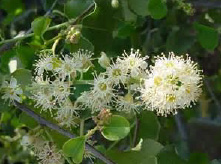
Holly Leaf Cherry
Prunus ilicifolia
(Holly Leaf Cherry)
Grows into a large shrub or small tree. Can reach height of over 20 feet tall. It has dense branches and shiny holly like evergreen leaves. White blossoms appear in Spring, followed by large sweet purple-red fruits in Summer and Fall. Attracts birds and bees.

Mexican Elderberry
Sambucus mexicana(Mexican Elderberry)
For more information, please visit the following websites:
Theodore Payne Foundation – www.theodorepayne.com
Las Pilitas Nursery – www.laspilitas.com
Rancho Santa Ana Botanic Garden – www.rsabg.org
El Nativo Growers – www.elnativogrowers.com
Intermountain Nursery – www.intermountainnursery.com
Join us for our annual Native Plant Sale! Saturday April 21, 2018 9am – 1pm Tehachapi RCD, 321 West C St., Tehachapi, Ca. 93561
Download our Native Plant Sale Pre-Order form.
Pre-Orders must be received by April 12, 2018 Our Online Store is coming soon.
If you need more information about the plants being offered and cannot access the website, please call ( 661) 825-5400
Click the Order Form Button to view and download.

